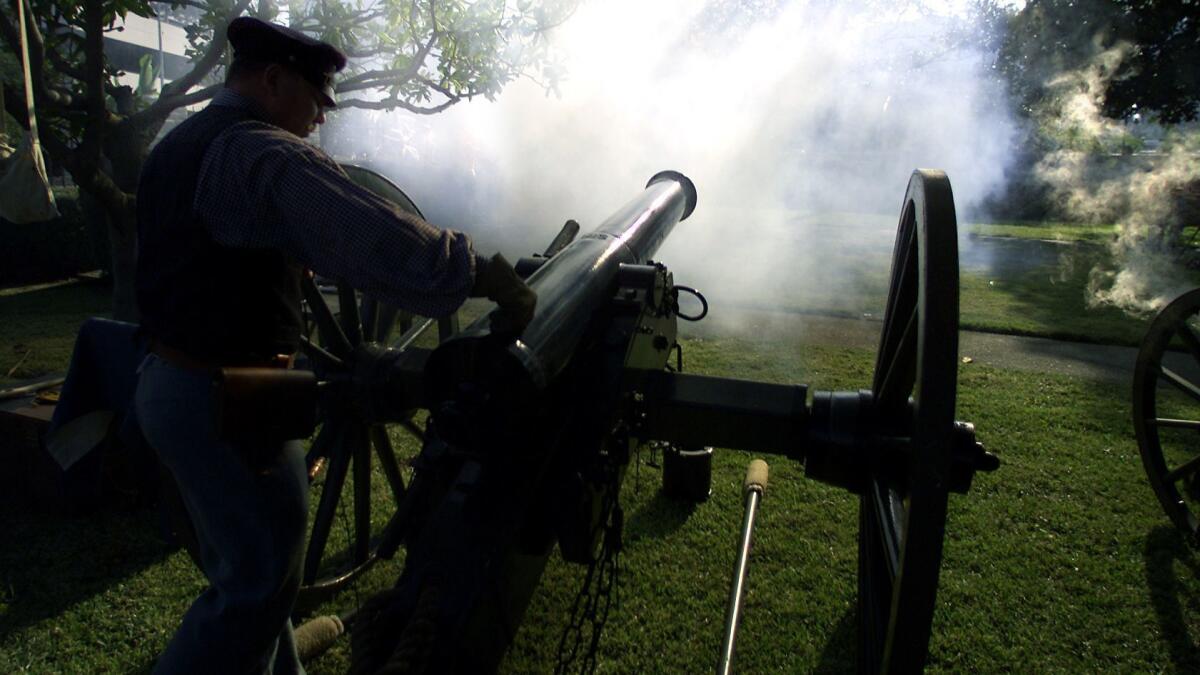Op-Ed: That time ‘Old Woman’s Gun’ saved Los Angeles

- Share via
Oct. 8, 1846, was a scorcher with “not a breath of wind,” as one battle survivor would recall. At dawn, U.S. Navy Capt. William Mervine landed 300 Marines, sailors and irregulars from the naval vessel Savannah at San Pedro.
Their objective: seize the Pueblo de Los Angeles, whose Spanish-speaking Californios had ejected a force of occupying Americans the week before. It was time, Mervine believed, for the Americans to teach the rebellious Mexicans a lesson.
The Battle of Dominguez Rancho, an early engagement of the Mexican-American War, was about to get underway. The story would not make its way into American textbooks.
Mervine addressed his men. Yes, they had no horses or pack animals, and it would be a hot march. But when they took Los Angeles, the cool waters of the Los Angeles River would be theirs, along with grapes and wine from nearby vineyards.
Although Los Angeles students don’t read much about them in school, the early battles of the Mexican-American War are closer than we think.
The Americans bivouacked at Dominguez Rancho, west of Compton. Late that night, an explosion echoed between the bluffs and Compton Creek. The Californios had a surprise: a small bronze cannon, its bore 2.5 inches in diameter. They scored no hits that night but did deprive the invaders of sleep.
At dawn, the Americans marched up a dirt road where Alameda Street runs today. They encountered an obstacle: mounted troops, backed by the field piece. The Californios were no ordinary cavalry. Writing after a subsequent battle, Gen. Stephen W. Kearny called them “the best riders in the world.”
Mervine deployed his troops in a square, an infantry posture employed against cavalry since antiquity. “When within about four hundred yards of them the enemy opened fire,” Lt. Robert C. Duvall wrote afterward. “Their horsemen kept out of danger, apparently content to let the gun do the fighting.”
In a Hollywood touch, each cannon blast was touched off by the hand-rolled cigarette of one Angeleno fighter, Ignacio Aguilar. With multiple dead and wounded, Mervine broke off the engagement. The battered expedition returned to San Pedro in “a pitiable condition,” Duvall wrote.
The cannon had a back story. Before the first American occupation, a gray-haired Californio patriot, Inocensia Reyes, hid the weapon in her garden. Dug up, the cannon “was mounted on a pair of wagon wheels by an English carpenter,” according to historian Hubert Howe Bancroft. Light and maneuverable, it delivered a hail of grapeshot.
One newspaper cited 13 American dead. Duvall tallied four and listed names: Hoey, Johnson, Berry and Sommers. Four Marines were slightly wounded. According to a newspaper account, surviving Marines referred sarcastically to “Capt. Mervine’s grapes, vintage of 1846,” when retelling the tale. The Angelenos had no casualties.
Enter the Fray: First takes on the news of the minute from L.A. Times Opinion »
Dr. Jerry Moore, professor of archaeology at Cal State Dominguez Hills, has unearthed evidence of the grapeshot: at least one iron shot ball, according to Luis Fernandez, executive director of the Dominguez Rancho Adobe Museum. Moore is planning further excavations, with the hope of pinning down the exact location of the battle.
L.A. Times columnist Jack Smith tracked down Reyes’ redoubtable cannon, “el conico,” in 1973 at the U.S. Naval Academy Museum at Annapolis. Following a subsequent battle in 1847, the Americans used the gun during their push into the Mexican homeland. It remains in Annapolis, a trophy of war. David Workman of El Pueblo de Los Angeles State Historic Park Commission told Smith that el conico should return to the Plaza, “where it belongs.” Maybe one day it will.
Reyes’ home stood near First and Alameda streets, where the Savoy condos sit today. There’s nothing there to mark her brave action. Her gesture lives on in the skirmish’s more romantic name: The Battle of the Old Woman’s Gun.
Although Los Angeles students don’t read much about them in school, the early battles of the Mexican-American War are closer than we think. For the Americans, there were no high callings, other than a drive to annex Mexican lands. In revisiting this past, we may find today’s battles staring back at us.
Erik Skindrud is a writer and editor in Los Angeles. He lives in Long Beach and passes the Dominguez Rancho battlefield each workday on the Blue Line.
Follow the Opinion section on Twitter @latimesopinion or Facebook
More to Read
A cure for the common opinion
Get thought-provoking perspectives with our weekly newsletter.
You may occasionally receive promotional content from the Los Angeles Times.






